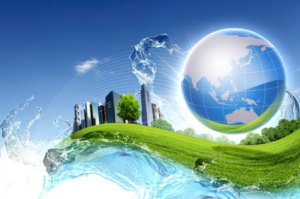
Types of Renewable Energy
Solar Energy
Every hour the sun beams onto Earth more than enough energy to satisfy global energy needs for an entire year. Solar energy is the technology used to harness the sun’s energy and make it useable. Today, the technology produces less than one tenth of one percent of global energy demand.
Many people are familiar with photovoltaic cells, or solar panels, found on things like spacecraft, rooftops, and handheld calculators. The cells are made of semiconductor materials like those found in computer chips. When sunlight hits the cells, it knocks electrons loose from their atoms. As the electrons flow through the cell, they generate electricity.
On a much larger scale, solar thermal power plants concentrate the sun’s energy as a heat source. The heat then boils water to drive a steam turbine that generates electricity in much the same fashion as coal and nuclear power plants, supplying electricity for thousands of people.
Solar energy is the cleanest and most abundant renewable energy source available, and the U.S. has some of the richest solar resources in the world. Modern technology can harness this energy for a variety of uses, including generating electricity, providing light or a comfortable interior environment, and heating water for domestic, commercial, or industrial use.
Wind Energy
Wind power is the conversion of wind energy into a useful form of energy, such as using wind turbines to make electrical power, windmills for mechanical power, wind pumps for water pumping or drainage, or sails to propel ships.
Large wind farms consist of hundreds of individual wind turbines which are connected to the electric power transmission network. Offshore wind farms can harness more frequent and powerful winds than are available to land-based installations and have less visual impact on the landscape but construction costs are considerably higher. Furthermore, offshore poses problems when considering accessibility for maintenance issues; the sea state must be calm for substantial work to be undertaken on an offshore wind farm. Having to wait for a period of sustained calm weather can result in an offshore turbine being out of action for a considerable amount of time, which significantly reduces income/energy capture.
Small onshore wind facilities are used to provide electricity to isolated locations and utility companies increasingly buy surplus electricity produced by small domestic wind turbines.
Hydro Energy
Hydropower is electricity generated using the energy of moving water. Rain or melted snow create streams and rivers that eventually run to the ocean. The energy of that moving water can be substantial, and it can be harnessed to create electricity.
Water energy has been harnessed for centuries. Farmers since the ancient Greeks have used water wheels to grind wheat into flour. Placed in a river, a water wheel picks up flowing water in buckets located around the wheel. The kinetic energy of the flowing river turns the wheel and is converted into mechanical energy that runs the mill.
In the late 19th century, hydropower became a source for generating electricity. The first hydroelectric power plant was built at Niagara Falls in 1879. In 1881, street lamps in the city of Niagara Falls were powered by hydropower. In 1882, the world’s first hydroelectric power plant began operating in the United States in Appleton, Wisconsin.
A typical hydro plant is a system with three parts: an electric plant where the electricity is produced; a dam that can be opened or closed to control water flow; and a reservoir where water can be stored. The water behind the dam flows through intakes and pushes against blades in a turbine, causing them to turn. The turbine then spins a generator to produce electricity. The amount of electricity generated depends on how far the water drops and the volume of water moving through the system. The electricity can be transported over long-distance electric lines to homes, factories, and businesses.
Hydropower is currently the cheapest way to generate electricity. Once a dam has been built and the equipment installed, the energy source—flowing water—is free. It is a clean fuel source that is renewed yearly by snow and rainfall.
